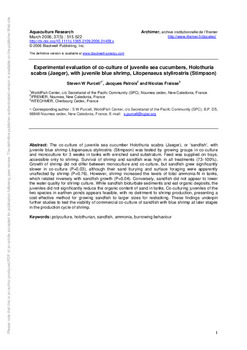Experimental evaluation of co-culture of juvenile sea cucumbers, Holothuria scabra (Jaeger), with juvenile blue shrimp, Litopenaeus stylirostris (Stimpson).

Citation
Purcell, S.W.; Patrois, J.; Fraisse, N. (2006). Experimental evaluation of co-culture of juvenile sea cucumbers, Holothuria scabra (Jaeger), with juvenile blue shrimp, Litopenaeus stylirostris (Stimpson).. Aquaculture Research, 37:515-522
The co-culture of juvenile sea cucumber Holothuria scabra (Jaeger), or ‘sandfish’, with juvenile blue shrimp Litopenaeus stylirostris (Stimpson) was tested by growing groups in co-culture and monoculture for 3 weeks in tanks with enriched sand substratum. Feedwas supplied on trays, accessible only to shrimp. Survival of shrimp and sandfish was high in all treatments (73-100%). Growth of shrimp did not differ between monoculture and co-culture, but sandfish grew significantly slower in co-culture (P=0.03), although their sand burying and surface foraging were apparently unaffected by shrimp (P=0.76).However, shrimp increased the levels of total ammonia-N in tanks, which related inversely with sandfish growth (P=0.04). Conversely, sandfish did not appear to lower the water quality for shrimp culture. While sandfish bioturbate sediments and eat organic deposits, the juveniles did not significantly reduce the organic content of sand in tanks. Co-culturing juveniles of the two species in earthen ponds appears feasible, with no detriment to shrimp production, presenting a cost-effective method for growing sandfish to larger sizes for restocking. These findings underpin further studies to test the viability of commercial co-culture of sandfish with blue shrimp at later stages in the production cycle of shrimp.
Permalink
Date Available
Type
Publisher
ISSN
1355-557X
Research Themes
Language